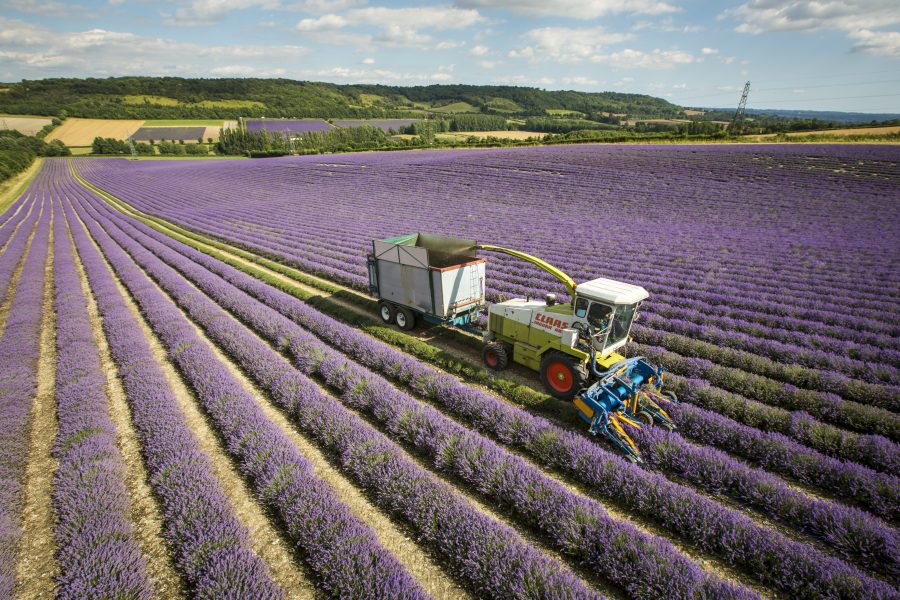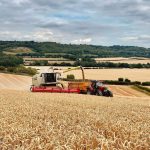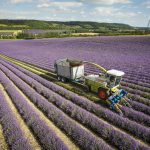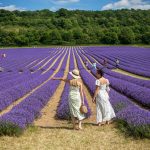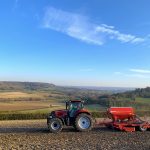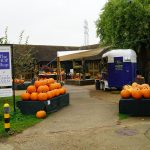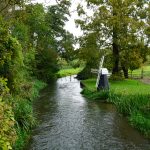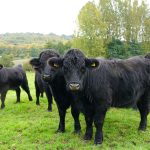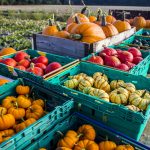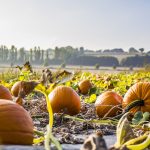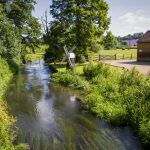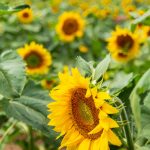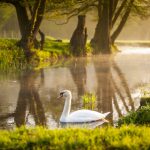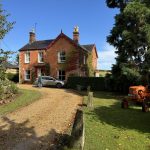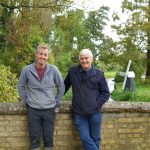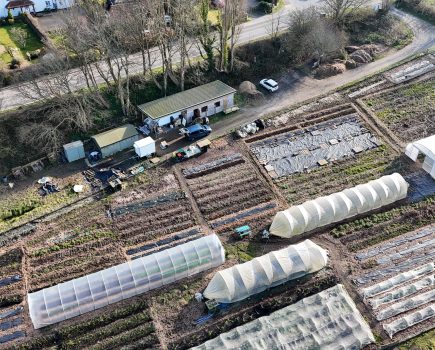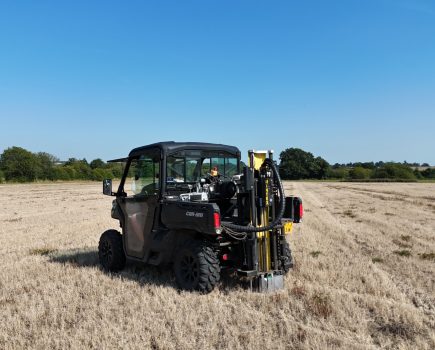This month Nigel Akehurst visits Castle Farm, nestled in the Darent Valley, north of Sevenoaks, Kent, to meet the Alexander family. With a busy, working 1,100-acre farm and an ambitious landscape-scale habitat and river restoration project underway, there’s much to discover.
On a crisp autumn day I arrived at Castle Farm, passing the Alexander family’s modern signage before crossing a charming bridge over the River Darent. As I parked near the farm shop, I couldn’t resist taking a few photos of the idyllic surroundings.
At the entrance, an Instagram-worthy display of pumpkins and squashes welcomed me. Inside the rustic farm shop, I was met by Lorna Roberts, who handles the farm’s social media (@castlefarmkent on Instagram), marketing and private events. During a brief tour of the shop, Lorna explained the farm’s history.
In 1892, her great, great grandfather James Alexander brought 17 milking cows down from Ayrshire, Scotland, by train. Today, the farm is managed by her parents, William and Caroline Alexander, with active involvement from her and her two brothers, Thomas, and Crispin, and their wives Sophie and Hazel, together with the dedicated Castle Farm team.
In 1985, Lorna’s parents established The Hop Shop to meet the growing demand for hop garlands and dried flowers in home interiors. By 1990, Castle Farm had become a major producer of dried flowers, cultivating over 70 varieties and winning several prestigious awards, including five gold medals at the Chelsea Flower Show.
In 1998, they diversified by planting lavender, and today, Castle Farm is the largest lavender grower in the UK, with 100 acres of the fragrant crop. Using their own on-farm distillery, they produce a wide range of Castle Kent Lavender essential oils. They collaborate with local bakeries and fudge makers to create lavender-infused foods, and additionally have developed a popular Sleepy Scent range for relaxation, and fragrant toiletries.
The shop also stocks Castle Farm’s own grass-fed native breed beef, apples and juices, plus locally sourced produce, alongside a variety of gifts, which are all sold in-store and online via their website: www.castlefarmkent.co.uk.
After our tour, we grabbed a flat white from their coffee cart and headed to the farm office, where Lorna introduced me to her father William and younger brother Crispin, who manage the agricultural enterprises.
Darent Valley Landscape Recovery Project
We started with an exciting discussion about the Darent Valley Landscape Recovery Pilot Project, a collaboration of 19 farmers and landowners committed to sustainable farming in the Kent Downs National Landscape. At the heart of this project is the River Darent, one of England’s rare chalk streams surrounded by wetlands, chalk grasslands and diverse farmland.
This initiative emerged from the Darent Valley Farmer Cluster, established by William and the farm’s immediate neighbors in 2022. Initially focused on enhancing environmental and higher-level stewardship schemes, the goal was to coordinate efforts for a greater environmental impact.
“The idea was that by working together, we could achieve more,” William explained.
Before embarking on a project, they secured funding from the Farming in Protected Landscapes programme, which allowed them to conduct habitat surveys across all the fields involved. In the summer of 2022, the government launched the landscape recovery option within the Environmental Land Management scheme, focusing on river-based projects.
Despite being in its early stages, the cluster, with help from Kent Wildlife Trust, applied for this new funding and, to their surprise, succeeded. Two years later they are finalising plans for significant landscape and land-use changes along the upper and middle reaches of the River Darent between Westerham and Farningham.
Restoring the river
Each landowner has designated specific fields to be used for the project, amounting to 1,200 hectares. A key objective is to restore the river’s natural flow by removing barriers and returning it to its original valley base. Over time, the river had been moved up the valley sides to power water mills.
Re-meandering the river is a key strategy that will slow the water, reduce downstream flooding and help recharge the chalk aquifer and increase biodiversity. Reconnecting the river to its floodplain also creates a more dynamic ecosystem, as Crispin explained, moving it beyond the “flooded vs. not flooded” binary.
Enhancing biodiversity
The main aim of the project is to boost biodiversity, thereby improving habitats for fish, plants and insects that depend on river and floodplain ecosystems. “There’s growing pressure on wetland insects, as wetlands have become much rarer,” William pointed out.
The group hopes to secure additional funding from natural capital investments like biodiversity net gain and carbon sequestration.
Rethinking grazing management
Participating in the landscape recovery project has prompted the family to rethink how it manages grazing fields, especially the floodplain meadows at Castle Farm and steeper hillsides over at their tenanted farmland, not included in the landscape recovery scheme.
Previously, the family fattened store cattle on a mix of grass and maize silage over winter. Now, the focus is on managing grasslands for conservation, with plans to join the Sustainable Farming Incentive’s (SFI) species rich grassland scheme (GRH6) and native breed supplement (SPM2).
To support these goals, they introduced a Pedigree Welsh Black Suckler herd. “They’re docile and adaptable, perfect for our sustainable, grass-fed beef vision,” Crispin said.
We headed out in Crispin’s pickup to see a group of recently purchased heifers from a pedigree breeder in Wales. Friendly and approachable, they lived up to their reputation.
Farm diversification: Apples, Lavender, and more
Next, we toured the heritage orchard, planted by Crispin’s grandfather in 1969. Norfolk Royal apples dominate, with some rows of Cox. The orchard now supports pick your own (PYO) activities and the apples are sold in the farm shop or pressed into Castle Farm Apple Juice.
Lavender tourism is another key aspect of the farm, with tens of thousands of visitors arriving for guided tours and picnics during the summer lavender season. This influx of tourists has been a major boon, especially after demand from fragrance companies dipped during Covid-19. Over just two weekends this year, visitors of 97 nationalities were recorded.
We also passed the PYO sunflower field, which has quickly become a hit with visitors, and we stopped to see the pumpkin and squash patch beside the traditional hop garden, used to grow hop garlands.
Arable crops and SFI considerations
Returning to the farmyard, Crispin explained their diverse arable crops, including winter wheat, barley, beans, linseed and spring oats, and the various cultivation methods they use; from ploughing to no-till, depending on conditions.
He said they were far from a full regen system but were open to the arguments and techniques, adding that they plant cover crops and use organic manures extensively across much of the farm every year, including dung, distilled lavender compost and sewer sludge.
Despite a tricky weather year, he said average yields had held up well at around nine to 10 tonnes to the hectare. In a good year they might get 10 to 11, while a bad year would be between eight and nine, he added.
When discussing the SFI, Crispin expressed frustration at the slow rollout of options. He also commented on the recent DEFRA underspend of £358 million, suggesting that farmers weren’t to blame for delays in SFI uptake, but that that the slow roll out was.
Looking to the future
As my tour of Castle Farm concluded, I reflected on the Alexander family’s impressive ability to blend tradition with forward-thinking sustainability. With projects like the Darent Valley Landscape Recovery and its expanding Welsh Black herd, it’s clear that Castle Farm is well-positioned for a sustainable and successful future.
Farm Facts
- 450-hectare family farm
- 40 hectares of lavender
- Arable crops include winter wheat, winter barley, winter beans, winter linseed and spring oats
- Hop garden for growing hop garlands for interiors
- PYO sunflowers
- Pumpkin patch
- Heritage orchard of Norfolk Royal (planted in 1969) and Cox apples
- On-site Castle Farm Shop opened in 1985 and expanded over the years – open Tuesday to Sunday.
- Farm tourism during lavender season
- Grass-fed beef sold through the farm shop
- Started a pedigree Welsh Black Suckler herd with plans to build up to around 40 cows
- Average nine to 10 tonnes per hectare on winter wheat this year
- Two years into the Darent Valley Landscape Recovery Pilot Scheme
- Adapted Claas Jaguar Harvester specifically for harvesting Lavender.
- River Darent
- Rectory Farmhouse and old Allis-Chalmers
- William Alexander and his son Crispin Alexander
For more like this, sign up for the FREE South East Farmer e-newsletter here and receive all the latest farming news, reviews and insight straight to your inbox.

